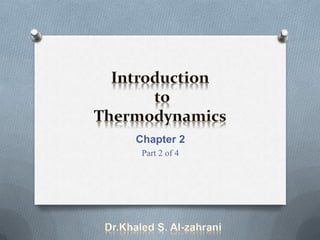
MET 211 introduction-to_thermdynamics_2-4_
- 1. Chapter 2 Part 2 of 4
- 2. 1st law of Thermodynamics O Closed System 𝑄 − 𝑊 = ∆𝑈 O Open system Dr.Khaled S. Al-zahrani
- 3. EInitial Efinal Q 𝒎 𝒐𝒖𝒕 Ui open Uf KEi system KEf PEi W PEf DEi 𝒎 𝒊𝒏 DEf Total Initial Energy Ei = Ui + K𝐸 𝑖 + PEi + DEi Total Final Energy Ef = Uf + K𝐸 𝑓 + PEf + DEf Conservation of energy law Ei + EE = Ef + EL Q W Dr.Khaled S. Al-zahrani
- 4. Conservation of energy law Ei + EE = Ef + EL ( Ui + K𝑬 𝒊 + PEi + DEi )+ Q = ( Uf + K𝑬 𝒇+ PEf +DEf )+ W Knowing that: 𝐷𝐸 𝑖 = 𝑃𝑖 × v 𝑖 and 𝐷𝐸 𝑓 = 𝑃 𝑓 × v 𝑓 𝑃𝐸 𝑖 = 𝑔 × 𝑍 𝑖 𝑃𝐸 𝑓 = 𝑔 × 𝑍 𝑓 𝐶2 𝑖 𝐶2 𝑓 𝐾𝐸 𝑖 = 𝐾𝐸 𝑓 = 2 2 Then: 𝐶2 𝑖 𝐶2 𝑓 ( Ui + +𝑔 × 𝑍 𝑖 +𝑃𝑖 × v 𝑖 )+ Q = ( Uf + +𝑔 × 𝑍 𝑓 +𝑃 𝑓 × v 𝑓 )+ W 2 2 If the specific Enthalpy is defined as: hi= 𝑝 𝑖 V 𝑖 + 𝑈𝑖 and 𝑓 = 𝑝 𝑓 V 𝑓 +Uf Then: 𝐶2 𝑖 𝐶2 𝑓 +𝑔𝑍 𝑖 + 𝑖 + Q = +𝑔𝑍 𝑓 + 𝑓 + W 2 2 Dr.Khaled S. Al-zahrani
- 5. Enthalpy (h) is a measure of the total energy of a thermodynamic system. It includes the internal energy, which is the energy required to create a system, and the amount of energy required to make room for it by displacing its environment and establishing its volume and pressure. H = U + pV Where H is the enthalpy of the system (in joules). U is the internal energy of the system (in joules). p is the pressure at the boundary of the system (in Pascal). V is the volume of the system, (in cubic meters). Dr.Khaled S. Al-zahrani
- 6. 𝐶2 𝑖 𝐶2 𝑓 +𝑔𝑍 𝑖 + 𝑖 + Q = +𝑔𝑍 𝑓 + 𝑓 + W 2 2 Usually the affect of Potential Energy is small enough to be ignored: 𝐶2 𝑖 𝐶2 𝑓 + 𝑖 + Q = + 𝑓 + W 2 2 OR 2 𝐶 𝑓 −𝐶 𝑖 Q-W= + (𝑓 − 𝑖) 2 Dr.Khaled S. Al-zahrani
- 7. Continuity of mass flow 𝑘𝑔 𝑚3 𝑚3 𝑉= 𝑚 𝑣 = × = 𝑠 𝑘𝑔 𝑠 Also 𝑚 𝑚3 𝑉 = 𝐴 𝐶 = 𝑚2 × = 𝑠 𝑠 From both: 𝑉= 𝑚 𝑣= 𝐴 𝐶 Then: 𝐴 𝐶 𝑚= = 𝑐𝑜𝑛𝑠𝑡𝑎𝑛𝑡 𝑣 If we have an Open system with constant flow 𝑚1 = 𝑚2 Or 𝐴1 𝐶1 𝐴2 𝐶2 = 𝑣1 𝑣2 Dr.Khaled S. Al-zahrani
- 9. Information manual: pages 83 & 84 Questions: 1 , 2 , 3 , 4 , 5 , 6 , 9, 10 and 11 Dr.Khaled S. Al-zahrani
